Dukes of Normandy
 This page was set up by Robert Sewell in July 2006 to show the descent
of the Dukes of Normandy through to Robert the Bruce, King of Scotland.
Robert Sewell graduated from McMaster University (Hamilton, Ontario, Canada)
in 1967 with a B.Sc. degree in chemistry. After a year of studies
at the University of Toronto's College of Education, he taught high school
science in Collingwood, Ontario for a year and then taught chemistry, physics
and general science in Hamilton, Ontario for twenty-nine years. Robert
Sewell retired from teaching in June 1998.
This page was set up by Robert Sewell in July 2006 to show the descent
of the Dukes of Normandy through to Robert the Bruce, King of Scotland.
Robert Sewell graduated from McMaster University (Hamilton, Ontario, Canada)
in 1967 with a B.Sc. degree in chemistry. After a year of studies
at the University of Toronto's College of Education, he taught high school
science in Collingwood, Ontario for a year and then taught chemistry, physics
and general science in Hamilton, Ontario for twenty-nine years. Robert
Sewell retired from teaching in June 1998.
Click
to contact Robert Sewell
Please visit the Sewell
Genealogy Site Map for other pages in this series.
The information presented here has
been taken from the following sources:
Frederick L. Weis and Walter L. Sheppard: Ancestral
Roots, 7th Edition, Baltimore, 1999
World Book Millenium 2000 Deluxe Edition,
© 1999 World Book Inc., © IBM Corp.
Microsoft Encarta Encyclopædia 99,
© 1993-1998 Microsoft Corporation
Norman F. Cantor (ed.): The Encyclopædia
of the Middle Ages, New York, 1999
Barnes and Hudson: The History Atlas of Europe,
New York, 1998
Berhard Grun: The Timetables of History,
New York, 1991
George Andrews Moriarty: The
Plantagenet Ancestry of King Edward III and Queen Philippa,
Mormon Pioneer Genealogical
Society, Salt Lake City, Utah, 1985.
Kenneth M. Setton (ed.): The Age of Chivalry,
National Geographic Society, 1969
David C. Douglas: William the Conqueror,
University of California, 1964.
Geoffrey H. White: The Complete Peerage,
Appendix D, Volume XI, 1949
G. A. Moriarty: The Companions of the Conqueror,
The American Genealogist, Oct. 1944.
The Book of History (18 Volumes), London,
1914
Richard Thomson: An Historical Essay on the
Magna Charta of King John (London, 1829)
Periodical Historical Atlas
of Europe, http://www.euratlas.com
Mediæval
History Guide,
http://historymedren.about.com/index.htm
Brian Tompsett, Royal Genealogical Data, http://www.hull.ac.uk/php/cssbct/genealogy/royal/
Encyclopædia Britannica, http://www.britannica.com/
(before they reverted to a pay service)
Planctus for William Longsword,
http://vlib.iue.it/carrie/documents/planctus/index.html
Genealogy
The Dukes of Normandy claimed an ancient
origin based on Norse and Icelandic sagas; but I have elected to begin
this genealogy with information from Moriarty's "Plantagenet
Ancestry" and Weis' "Ancestral Roots" which are considered much more reliable. For full details, please see:
Frederick L. Weis and Walter L. Sheppard: Ancestral
Roots,
7th Edition, Baltimore, 1999, Line 121E. (Note that in 121E 18, Weis
acknowledges that Rolf Ragnvaldesson, a.k.a. Rolf the Ganger, Rollo the
Viking, etc. could easily have been two persons . . . father and son.)
and:
George Andrews Moriarty: The
Plantagenet Ancestry of King Edward III and Queen Philippa,
Mormon Pioneer Genealogical
Society, Salt Lake City, Utah, 1985, pages 10 and 11. Some folks prefer to begin their genealogy with even earlier persons as mentioned in
the ancient sagas of Norway and Iceland. For more, please click on Norse
Sagas.
Generations One to Four below also
appear in Florence Van Rensselaer, The Livingston Family in America
and Its Scottish Origins, New York, 1949, pages 55 & 56. To
view this line, click HERE .
Why are some names different on other pages?
| "In the early middle ages and earlier we frequently find the same person
with two or perhaps more different surnames. The given name may be followed
by a patronymic (for example, 'Fitz John'), sometimes by a descriptive
(for example, 'the Red' - perhaps in Latin or Norman French) and sometimes
by a place name (for example, 'de Cave'). Any of these can, over the years,
develop into a fixed surname, but in the earlier years the same person
may in different records appear with two or more of these 'surnames' of
these types, and if he holds land in two or more places, perhaps with more
than one place name. And any of these can be correct. Given names may be
in French or the English of the period depending on the record where it
appears (for example, Piers or Peter), and either can be correct. No attempt
is here made, nor should it be, to bring these names into uniformity since
the name used should follow the evidences cited."
. . . Weis and Sheppard: Ancestral Roots, Baltimore,
1999, page ix
|
Generation One
Halfdan the Old had a son:
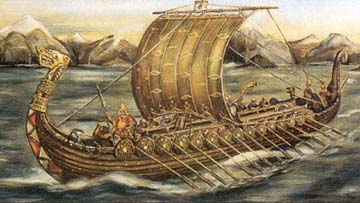
Generation Two
Ivar Oplaendinge, Earl of
the Uplands
Flourished circa 800
Ivar had a son:
-
Eystein "the Noisy" Glumra
Generation Three
Eystein "the Noisy" Glumra,
Earl of the Uplands
Born in 788
Eystein married to Ascrida Ragnvaldsdottir. For Acrida's
descent , please click Norse
Sagas.
Eystein and Ascrida had the following children:
-
Ragnvald I "the Wise" Eysteinsson
-
Sigurd I Riki "the Powerful" Eysteinsson, Earl of Orkney,
died in 982
-
Swanhilda Eysteinsdottir who married King Harald I Haarfayer
(circa 848/852 - 936) Harald was King of Norway in 883 and he was deposed
or abdicated in 932.
Generation Four
Ragnvald I "the Wise" Eysteinsson,
Earl of More
Died about 894
Ragnvald married first to Groa and they had the following
children:
-
Hallad Ragnvaldsson who became Earl of Orkney circa 983.
-
Turf-Einar Ragnvaldsson, Earl of Orkney
-
Hrollaug Ragnvaldsson
Ragnvald married second to Hiltrude (Ragnhild) Hrolfsdottir
and they had the following children:
-
Ivar Ragnvaldsson
-
Rolf Ragnvaldsson
-
Thori "the Silent" Ragnvaldsson, Earl of More
Generation Five
Rolf Ragnvaldsson, also known
as Rolf the Ganger, Rolf Wend-a-Foot, Rolf the Viking and
Rollo of Norway. He was baptized
as "Robert" and became the 1st Duke of Normandy
Born circa 846/860
Died in 932
Note: The line shown on this page has Rolf and Rollo as being the same person. For further details, please see:
George Andrews Moriarty: The Plantagenet Ancestry of King Edward III and Queen Philippa, Mormon Pioneer Genealogical Society, Salt Lake City, Utah, 1985, page 11
and:
Frederick L. Weis and Walter L. Sheppard: Ancestral Roots, 7th Edition, Baltimore, 1999, Line 121E 18.
It has been suggested that Rolf Ragnvaldsson (a.k.a. Rolf the
Ganger) and Rollo of Norway (1st Duke of Normandy) are two people,
Rollo being a son of Rolf. This would be especially tenable if Rolf was
born as early as 846 AD; in which case he would have been an
unrealistic 65+ years old or so when he laid seige to Paris and then
went on to live to the almost unbelievable age of 86 when he died in
932. |
Encyclopeadia Britannica states that
Rolf was a "Scandinavian rover who founded the duchy of Normandy.
Making himself independent of King Harald I of Norway, Rolf sailed off
to raid Scotland, England, Flanders, and France on pirating expeditions
and, about 911, established himself in an area along the Seine River. Charles
III the Simple of France held off his siege of Paris, battled him near
Chartres, and negotiated the treaty of Saint-Clair-sur-Epte, giving him
the part of Neustria that came to be called Normandy; Rolf in return agreed
to end his brigandage. He gave his son, William (I) Longsword, governance
of the dukedom (927) before his death. Rolf was baptized as 'Robert' in
912 but is said to have died a pagan."
Laying siege to Paris appears to
have been a popular pastime in the late 9th and early 10th century. Asser
wrote in his Life of King Alfred: "In the year of our
Lord's incarnation, 886, which was the thirty- eighth since the birth of
Alfred, the (Viking) army . . . directing their ships to the river called
the Seine, and sailed up it as far as the city of Paris, and there they
wintered and measured out their camp. They besieged that city a whole year,
as far as the bridge, that they might prevent the inhabitants from making
use of it; for the city is situated on a small island in the middle of
the river; but by the merciful favour of God, and the brave defence of
citizens, the army could not force their way inside the walls."
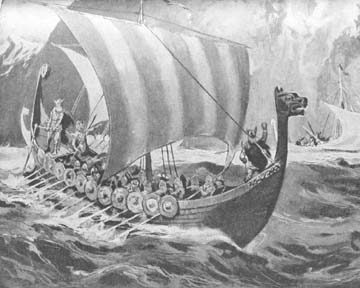
|

|
Paris besieged by Rolf the Ganger who
became the 1st Duke of Normandy
The small island in the middle of the Seine was originally the entire
city.
Rolf married first in 886 to
Poppa, whose ancestry is uncertain. Poppa may have been a daughter of
Count Berenger of Bayeux, or she may have been a granddaughter
of Seigneur Pépin (II), Count of Peronne who was a great grandson
of Charlemagne. Please click on The Ancestry of Poppa for details. For her possible descent from Seigneur Pépin, please click on Count
of Peronne.
Rolf and Poppa had the following children:
-
William (I) Longsword of Normandy
-
Gerloc or Adela of Normandy (died after January 14, 962).
Adele married in 935 to William (I) "Tête d' Etoupes", Count of Poitou
(born circa 915, died April 3, 963). Adela and William had the following
children:
-
William (II) "Fier de Bras", Count of Poitou (born circa
937, died February 3, 995) whose great grandson was William
"The Troubadour" of Poitou and Aquitaine, the first known troubadour,
or lyric poet, employing the Romance vernacular called Provencal and grandfather
of Eleanor of Aquitaine. (Reference: George
Andrews Moriarty: The Plantagenet Ancestry of King Edward III and
Queen Philippa, Mormon Pioneer Genealogical Society, Salt Lake
City, Utah, 1985, pages 35 and 36)
-
Adelaide of Poitou (born circa 945 - 950, died circa 1004)
who married Hugh
Capet, King of France. (Reference: George
Andrews Moriarty: The Plantagenet Ancestry of King Edward III and
Queen Philippa, Mormon Pioneer Genealogical Society, Salt Lake
City, Utah, 1985, pages 11 and 27)
Rolf is said to have had other wives and many more children.
Generation Six
William (I) Longsword, 2nd Duke of Normany
Died (murdered) on December 17, 942
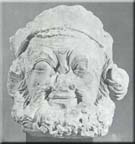
|
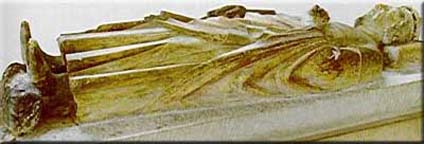
|
|
William Longsword
|
Effigy of William Longsword
|
Please visit the "Planctus for William Longsword"
at http://vlib.iue.it/carrie/documents/planctus/index.html
This beautiful site offers a full translation and commentary on the
Planctus or Mourning Poem for William Longsword. As well, visitors
are invited to ". . . to download all the files on this site for use on
your home computer." This feature enables you to download the entire
site and work through it at your leisure.
William Longsword was involved in a
war in the late 930's against Arnolph
I "the Great", Count of Flanders. Some sources state that a peace
conference was held in December 942, and that Arnolph arranged for
the murder of William Longsword at that time. Other sources state that
"Arnolph waged war against William of Normandy, whom he defeated and slew".
William married first to Sprota (Adela)
of Senlis, a daughter of Hubert (I), Count of Senlis and Vermandois who
was a great great grandson of Charlemagne. Click on Count
of Senlis for this descent.
William and Sprota had the following children:
-
Richard (I) "the Fearless" of Normandy
William married second in 935 to Luitgarda of Vermandois,
a niece of his first wife Sprota.
Generation Seven
Richard (I) "the Fearless", 3rd Duke of Normandy
Born in 933 at Fecamp, France
Acceded: 942
Died on November 20, 996 at Fecamp, France
Richard married first in 960 to Emma of Paris (died 962),
a daughter of Hugh
"the Great" Capet.
Richard married second to Gunnor of
Crêpon. It is quite probable that Richard and Gunnor had some
of their children prior to Richard's marriage to Emma of Paris (960 - 962).
Richard and Gunnor married after Emma's death, thereby legitimizing all
the children.
A relative of Gunnor named Osbern
was a powerful Steward or Dapifer of Normandy during the minority of William
the Conqueror. Osbern was murdered in 1040 during an attempt on the
life of the young Duke William that occurred right in William's bedroom.
Osbern was almost certainly Gunnor's nephew, a son of her brother Herfast;
although some sources claim Osbern was Gunnor's brother.
Richard and Gunnor had the following children:
-
Richard II "the Good" of Normandy
-
Mauger, Earl of Corbeil
-
Robert, Count of Évreux and Archbishop of Rouen (died
on March 16, 1037) who supported his young nephew Robert "the Devil" and
later his son Duke William. Despite being an Archbishop, Robert had
a wife and the following sons:
-
Richard, Count of Évreux
-
Ralph of Gacé who is said to have arranged the murder
in 1040 of his cousin Gilbert "Crispin", Count of Brionne, who was chief
tutor of Duke William at the time.
-
William
-
Matilda
-
Emma of Normandy, born circa 986, died on March 14, 1052.
Emma married first on April 5, 1002 to King Æthelred II "the Unrede"
of England, and they had a son:
Emma married second on July 2, 1012 to Canute II, King of
England and Denmark, and they had a son:
-
Hardicanute, King of England 1040 - 1042
-
Hedwig (Hawise) who married Geoffrey, Duke of Brittany.
Their son:
-
Alan (III), Count of Brittany who was a guardian of the young
Duke William and is said to have "died suddenly", probably murdered, in
October 1040.
-
Beatrix of Normandy
-
Godfrey of Brionne & Eu. Please click on De
Clare for this line. His son,
-
Gilbert "Crispin", Count of Brionne, chief tutor of Duke
William for a brief period in 1040. He is said to have been murdered
on the orders of his cousin Ralph of Gacé.
-
William of Hiesmes, Count of Eu
Generation Eight
Richard (II) "the Good", 4th Duke of Normany
Acceded: 996
Died on August 28, 1026
Richard married first about 1000 to Judith
of Brittany, daughter of Conan the Crooked, Duke of Brittany
Richard and Judith had the following children:
Richard (III), 5th Duke of Normandy who is said to
have been poisoned and died on August 6, 1028. Richard married in
January 1027 to Princess Adela (Alix) Capet, daughter of King Robert
II "the Pious" Capet, King of France. After Richard's death
in 1028, Princess Adela re-married in 1028 to Baldwin V "the Pious", Count
of Flanders. Their daughter Mathilda married William the Conqueror.
Please click on
Baldwin
V for the continuation of this line. Richard and Adela had a son:
-
Nicholas who following his father's death was relegated to a monastery
(first to Fécamp and then Saint Ouen in Rouen) and Robert "the Devil"
took over as 5th Duke of Normandy. In later life, Nicholas
was a loyal supporter of his cousin William the Conqueror. About
1042, Nicholas became Abbot of the monastery of Saint Ouen.
Richard (III), 5th Duke of Normandy had by an unknown mistress:
-
Alice of Normandy who married Ranulph (I), Vicomte of the Bessin.
Their great grandson Ranulph de Gernon, Earl of Chester married Maud
of Gloucester. Ranulph and Maud were 4th cousins, their common ancestor
being Richard (II) "the Good", 4th Duke of Normandy. See Frederick L. Weis
and Walter L. Sheppard: Ancestral Roots, 7th Edition,
Baltimore, 1999, Line 132A
Robert (I) "the Devil" Normandy
Alice (Adelaide) who married Rainald, Count of Burgundy;
their sons:
-
Guy, Count of Burgundy who attempted to seize control of
Normandy in 1047.
-
William (I), Count of Burgundy (died in 1087) who married
Stephanie de Longwy, daughter of Adalbert (III), Count de Longwy. Their
daughter:
Eleanora (Judith) of Normandy who married Baldwin
IV, Count of Flanders as his second wife.
Richard married second in 1017 to Estrith (Margaret)
of Denmark, daughter of Sweyn Forkbeard, King of Denmark and Sigrid "the
Haughty"; and they had a divorce circa 1017/18. (Estrith married
Richard's son Robert "the Devil" in 1031, and they had a divorce after
a year or so as well.)
Richard married third about 1024 to Papia of Envermeu
and they had the following children:
-
Mauger, Archbishop of Rouen
-
William, Count of Arques
-
Papia, said to have married "Turchetil" who may have
some connection to Turchetil who was a guardian of the young William
the Conqueror.
Generation Nine
Robert (I) "the Devil", 6th Duke of Normandy
Born circa 1008
Acceded on August 6, 1027
Died between July 1 and 3, 1035 at Nicaea in Bithynia
while returning from a pilgrimage to the Holy Land. Ancient Nicaea
was located about 65 miles south east of Constantinople. Referred
to as Robert "the Devil" (Moriarty, Planatagent Ancestry,
pg. 13), he is also known as Robert "the Magnificent".
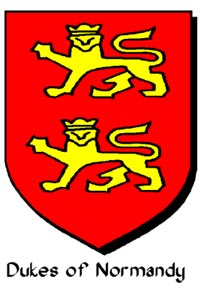
Robert had a girlfriend named
Herleva. Both were under twenty, possibly as young as seventeen,
when Herleva became pregnant with their first child who was to become William
the Conqueror. Herleva's father was Fulbert, who was probably a tanner.
Fulbert has been described as "polinctor" which translates more readily
as "embalmer", or one who prepares corpses for burial, but the traditon
is strong that he was a tanner; and Falaise, Normandy was famous for its
tanneries. Apparently there were no hard feelings with regard to
Robert and Herleva having a child without undergoing the formality of a
church ceremony. Fulbert was given a subordinate office at the ducal
court, and Herleve's brothers, Osbert and Walter, appear as witnesses to
various charters. As well, while Walter was never an official tutor
or guardian of the young Duke William, he watched over William during his
perilous childhood; and on occasion saved his life by snatching the boy
from his cot and carrying him for safety to spend the rest of the night
in the cottage of a poor family.
It would appear that Robert and Herleva
"broke up", but once again, there do not seem to have been any hard feelings.
Herleva married to Herluin, Vicomte of Contreville, and they had two sons:
Odo, Bishop of Bayeux and Earl of Kent; and Robert, Count of Mortain; both
of whom were very close to their half brother, William the Conqueror; and
both of whom were present at the Battle
of Hastings.
In late 1034, curiosity or devotion
induced Robert (I) "the Devil", 6th Duke of Normandy, to undertake a pilgrimage
to the Holy Land, where the fatigues of the journey and the heat of the
climate so impaired his consitution he died at Nicaea (in the area of Iznik
in modern Turkey) on his way home.
Robert and Herleva had the
following children:
-
William the Conqueror
-
Adeliza (Adelaide) of Normandy, (1029 - 1080/85) who married
perhaps two or three times: first to Enguerrand (III) d'Aûmale,
Count of Ponthieu; second (maybe) to Lambert (II) von Boulogne, Count of
Lens; and third to Eudes (Odo), Count of Champagne. Adeliza had several
children, one of whom was most likely by Enguerrand (III) d'Aûmale,
Count of Ponthieu:
-
Judith of Normandy, born about 1054 who married Waltheof,
1st Earl of Huntingdon. Their daughter:
Robert married in 1031 to Estrith, daughter
of Sweyn Forkbeard, King of Denmark. They had a divorce in 1032.
Estrith had been previously married to Robert's father, Richard "the Good"
and they had a divorce after a year or so as well. We are left to
wonder if Estrith, whose mother was known as "Sigrid the Haughty", was
difficult to get along with.
Generation Ten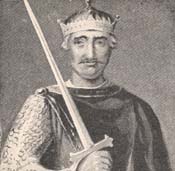
William the Conqueror, King of England
Born in 1028, probably in the autumn, at Falaise, Normandy,
France.
Duke of Normandy 1035-1087 and King of England 1066-1087.
Died early in the morning on Thursday, September 9, 1087
at Hermentrube, Near Rouen, France.
Interred at the Monastery of St. Stephen, Caen, Normandy
which he had founded.
William invaded England, defeated
and killed his rival Harold at the Battle of Hastings, and became King.
William was noted for his efficient if harsh rule. Please click on William
the Conqueror for more information and links.
William married in 1053 at the Cathedral of Notre Dame
d'Eu, Normandy to Matilda of Flanders. Please click on Mathilda
of Flanders for her descent from the Kings of France and Charlemagne.
William and Mathilda had the following children:
-
Robert (II) Curthose, Duke of Normandy (1054 - 1134)
-
Richard, Duke of Bernay (1055 - 1075, died without issue)
-
Cecilia, Abbess of Holy Trinity, Caen (1056 - 1127)
-
Adeliza, who became a nun (born 1055)
-
William (II) Rufus, King of England from 1087 to 1100
born 1056/60
-
Constance, (1066 - 1090) who married Alan IV, Count of Brittany
-
Adela, (1067 - 1137) who married Stephen, Count of Blois,
their son:
-
Stephen, King of England 1135 - 1154 who married Matilda, a granddaughter of Malcolm III Cænmore, King of Scotland.
-
Agatha (born about 1064)
-
Matilda who was said by Sir Bernard Burke and possibly
others as well to be the same as Gundred who married William
de Warenne, 1st Earl of Surrey but this has since been disproved. (See
Burke: Dormant and Extinct Peerages, 1866, pages 568 and
569; C.T.Clay: Early Yorkshire Charters and H. Prentout
Études
sur Quelques Points de l'Histoire de Guillame le Conquérant
as described under Surrey in The Complete Peerage.)
-
Henry (I) Beauclerc
Generation Eleven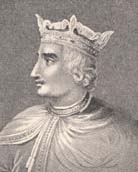
Henry I Beauclerc, King of England
Born about September 1068 at Selby, Yorkshire, England
Died on December 1, 1135 at St. Denis-le-Fermont, Near
Gisors
Henry reigned as King of England
from 1100 until his death in 1135. In 1106 he captured his brother Robert
and took over as Duke of Normandy from 1106 to 1135. Henry was nicknamed
"Beauclerc" (fine scholar) for his above average education. During his
reign, the differences between English and Norman society began to slowly
evaporate. His reign is notable for important legal and administrative
reforms, and he proved to be a hard but just ruler. He is reputed to have
died from over consumption of lampreys, but there is a good possibility
that the excess of lampreys only gave him a bad case of indigestion and
that a carelessly dispensed dose of purgative was in fact the cause of
his demise.
King Henry (I) Beauclerc had the following son circa 1090,
said to be his eldest son. The identity of the mother is uncertain, although
some sources name Sybilla (Sibyl) Corbet:
-
Robert de Caen, Earl of Gloucester, born circa 1090.
Robert was the eldest of a vast number of natural (illegitimate) children
of King Henry I. Click on The
Children of King Henry for details.
Henry married first on November 11, 1100
to Matilda (Edith) of Scotland, a sister of King David "the Saint" of Scotland.
Please click on Matilda
for her descent from the ancient Kings of Scotland.
Henry and Matilda had the following children:
-
Euphamia, born July 1101, died young.
-
Matilda (or Maud) of England, (1103/04
- 1167) who married first Henry V of Franconia, Emperor of the West (Also
referred to as Emperor of Almain and Emperor of Germany; he d.s.p. May
22 or 23, 1125.) Because of her first marriage, Matilda is sometimes referred
to as "Matilda the Empress", but more frequently as "Lady of the English"
or "Heiress of England", or sometimes "Queen of the English". Matilda married
secondly in 1127 Geoffrey "the Fair" Plantagenet, Count of Anjou and Maine.
Click on Geoffrey
Plantagenet for his descent. Matilda and Geoffrey had a son:
-
Henry (II) Curtmantle, King of England was born on March
25, 1133. The first of the Plantagenet or Angevin Kings of England,
he married Eleanor
of Aquitaine and became one of the most powerful mediæval English
kings and European monarchs. For more about this king, his wife,
and their descendants, click on Henry
II Curtmantle. Their sons included:
-
King Richard (I) "the Lion-Hearted"
-
King John who, under considerable pressure, granted the Magna
Charta and then attempted to welsh on the deal. Click on King
John for details.
-
William the Aetheling, born before August 5, 1103 and drowned
in the sinking of the White Ship on November 25, 1120. When the white
ship was wrecked on the deadly rock a boat was launched and William, the
King's only legitimate son, was rowed to safety. The cries of his half-sister
Maud, Countess of Perche, induced him to return to the wreck where they
sank together. This was considered by some to be punishment for Henry's
sins of lust in having so many illegitimate
offspring.William was married to Isabella (Matilda), but they didn't
have any children. After her husband drowned she became a Nun, and
was elected abbess of Fontevrault.
-
Richard (Some sources say he drowned in the sinking of the
White Ship on November 25, 1120. Other sources say he died in infancy,
and the Richard who drowned on the White Ship was one of Henry's vast brood
of illegitimate children. Regardless, he predeceased his father.)
Henry married second on January 29, 1122, to Adeliza of Louvain.
They don't appear to have had children.
Generation Twelve
Robert de Caen, Earl of Gloucester
Born circa 1090 at Caen, France
Died on October 31, 1147 at Bristol
Robert de Caen, called "the Consul", married to Mabel
(Maud) Fitz Hamon, daughter and heiress of Robert Fitz Hamon, Lord of Glamorgan
and his wife Sibyl who was a daughter of Roger de Montgomery, 1st Earl
of Shrewsbury. Roger de Montgomery is shown on the Battle Abbey Roll and
the Dives-sur-Mer List as having accompanied William the Conqueror in 1066.
While it cannot be proven, Roger de Montgomery may have been present at
the Battle of Hastings
on October 14, 1066.
Robert de Caen and Mabel Fitz Hamon had the following
children:
-
William Fitz Robert
-
Roger, Bishop of Worcester
-
Hamon
-
Philip
-
Richard, Lord of Creully
-
Maud who married Ranulph
de Gernon, Earl of Chester. Maud and Ranulph were 4th cousins, their
common ancestor being Richard (II) "the Good", 4th Duke of Normandy. See
Frederick L. Weis and Walter L. Sheppard: Ancestral Roots,
7th Edition, Baltimore, 1999, Line 132A
-
Mabel
-
Richard
-
Robert
|
The surnames used by these persons include
the following:
-
Fitz Robert
-
de Caen
-
of Gloucester
|
Generation Thirteen
William Fitz Robert, Earl of Gloucester
Died on November 23, 1183
William married circa 1150 to Hawise
de Beaumont, daughter of Robert de Beaumont, 2nd Earl of Leicester
and his wife Amice
de Montfort.
William and Hawise had the following children:
-
Mabel
-
Amicia, Countess of Gloucester
-
Isabel of Gloucester who married in
1189 and divorced in 1199 to King
John of England.
-
Robert Fitz William (died in 1166)
Generation Fourteen
Amicia, Countess of Gloucester
Died in 1225
Amicia married circa 1180 to Richard de Clare, Earl of
Hertford and Clare who was one of the 25 Sureties of the Magna Charta.
Please click on Richard
de Clare for his descent.
Richard and Amica had the following children:
-
Gilbert de Clare
-
Richard (Roger) de Clare
-
Matilda (Maud) de Clare; married William de Braiose
who was murdered by King John (starved to death) in 1210 at Corfe or Windsor
Castle. (See Weis, Ancestral Roots, 7th Ed. 1999, Lines 29A-28 and
63A-28)
-
Rose (Joan) de Clare
Generation Fifteen
Gilbert de Clare, 4th Earl
of Gloucester, Earl of Hertford and Clare
Born circa 1180
Died on October 25, 1230 at Penros, Brittany
Gilbert de Clare was one of the 25 Sureties of the Magna
Charta. Click on Gilbert
de Clare.
Gilbert married on October 9, 1217
at Tewkesbury Abbey, Gloucester to Lady Isabella Marshal, daughter of William
Marshal, Earl of Pembroke and Isabel de Clare. Please click on Marshal
for the descent of Lady Isabella Marshal.
Gilbert and Isabella had the following children:
-
Amicia de Clare who married in 1226 to Baldwin de Reviers,
Earl of Devon
-
Richard de Clare, Earl of Gloucester, born on August 4, 1222
-
Isabel de Clare
-
Sir William de Clare born on May 18, 1228 and poisoned while
eating breakfast in 1258.
-
Gilbert de Clare, a Priest, born on September 12, 1229
-
Agnes de Clare
Generation Sixteen
Isabel de Clare
Born on November 8, 1226
Died in 1254, after July 10
Isabel married on May 12, 1240 to Robert de Bruce, Lord
of Annandale and they had a son:
-
Robert Bruce, Earl of Carrick
For the continuation of this line, click on Robert
Bruce, Earl of Carrick.
Click to return to the top
of this page.
Please visit the Sewell
Genealogy Site Map for other pages.
 This page was set up by Robert Sewell in July 2006 to show the descent
of the Dukes of Normandy through to Robert the Bruce, King of Scotland.
Robert Sewell graduated from McMaster University (Hamilton, Ontario, Canada)
in 1967 with a B.Sc. degree in chemistry. After a year of studies
at the University of Toronto's College of Education, he taught high school
science in Collingwood, Ontario for a year and then taught chemistry, physics
and general science in Hamilton, Ontario for twenty-nine years. Robert
Sewell retired from teaching in June 1998.
This page was set up by Robert Sewell in July 2006 to show the descent
of the Dukes of Normandy through to Robert the Bruce, King of Scotland.
Robert Sewell graduated from McMaster University (Hamilton, Ontario, Canada)
in 1967 with a B.Sc. degree in chemistry. After a year of studies
at the University of Toronto's College of Education, he taught high school
science in Collingwood, Ontario for a year and then taught chemistry, physics
and general science in Hamilton, Ontario for twenty-nine years. Robert
Sewell retired from teaching in June 1998.








